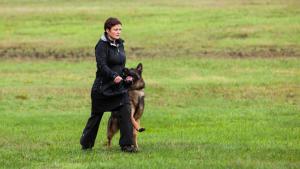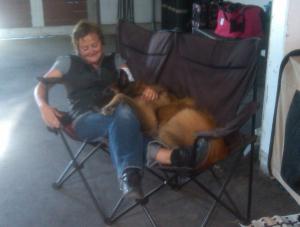
My job as a trainer is ultimate fixing relationships between dogs and their people. It doesn’t matter how bad the dog is – if the relationship is great, retraining is easy. If the relationship is not, retraining will slowly improve until the relationship is harmonious, then training will leap ahead.
Relationships between a human and a dog can be broken down into three key pieces: beliefs, leadership and intent.
BELIEFS:
If you had to describe your dog in three words what would they be? Basil is cheeky, naughty and a proud stallion. Neville would be entertainer, honest, and hard-working.Do the same for your dog. Are your words equally positive? Or do your words reflect annoyance, or pity? Do you feel sorry for your dog? Or does he push your buttons? These words are your beliefs about your dog.These words are what you feel when you think of your dog. You tell him this every single time that you pick up his leash. Your beliefs are spoken every single time you look into his eyes, kiss his little ears, and pick up his leash.Basil is my wonder-dog, though he has never been easy. He challenged me on everything that I asked of him, still challenges every rule he has, and generally, he is a handful. If Basil might get away with something – he will try.If I were to compare Basil to his younger brother Neville, Basil is a lot of work. It takes energy and strength to get him to cooperate. I don’t compare my dogs, at least I try not to, but after a fabulous smooth-sailing training session with Neville, I can sometimes have begrudging thoughts as Basil adds his own flair and twist on the exercises that he can master with his eyes closed.Once Basil and I fell into a rut. I started to focus on his very few flaws. This was accentuated by the fact that I was training Neville first, who would die rather than be dishonest and tried his hardest. Neville gives all he has and wants to please me. Training Basil after my A-student accentuated his naughtiness. As soon as I realized this, I trained Basil first, then I could enjoy him for the Stallion that he is, and could appreciate his tenacity and determination, rather than be annoyed at him for it.When I didn’t have the comparison of Keener Neville, who would do a back flip simply because I suggested it, it became easy to admire Basil for his attributes. As soon as you can admire someone, everything changes. Our training became really fun, unpredictable, and a tad wild! I learned to love his challenges that he threw at me. I can’t say my Basil has ever changed due to my thoughts, but neither do I want Basil changed. He is perfect as he is. I simply had to train him before Neville to appreciate that.Be aware of how you look at your dog. It is up to you to decide what you would like to focus on – You can define them as their flaws and previous failures, or as their strengths and thousands of successes. Focus on their positive traits and have positive beliefs about your dog.
LEADERSHIP:
Leadership and enjoyment are opposing forces to my clients, but they need to be interconnected. Militancy is not leadership. Time spent with your dog should be enjoyable for both of you. However, your dog must also heed your instructions and needs to look to you for advise. I like my dogs to ask for permission such as; “may I chase the squirrel?” Hilda continues to ask “May I eat the other dog?”
Leadership is about demonstrating and coaching on what is right, and never giving up your role, even when you are tired, or have company over.
Leadership is about respect. You must respect your dog for who they are, for who they will become, for their genetics, and for their ancestry. Leaders should be optimists, seeing the best in a dog, seeing their potential, rather than zoning in on their perhaps giant flaw!
Hilda will always ask that same question, because her ancestors tell her to. Dog Aggression is inherent in Irish Terriers, meaning her struggles are honest struggles. I as her leader am always ready for it, always smile, and always reply “Not today dear”. I don’t pretend Hilda is someone else. I deliberately added a scrappy terrier to my household because I wanted a challenge, which I underestimated upon purchase! I’m never surprised, nor saddened, when she asks to eat someone. What I am is pleased about are the hundreds of occasions where she bites her tongue, and refrains!
When she does bite her tongue, I always feel proud and she knows this. It is very challenging for her to show restraint and impulse control with her ancestors telling her to not listen to her training. I appreciate the effort that she gives me. I won’t accept less, but I do appreciate her effort, and understand her challenges.
My job as her leader is to guide her through her challenges, and give her a chance to show me how brilliant she can be. Being a leader is about respect, which includes me feeling what my dog is feeling, and operating from where she is at. I understand her. And I respect her for the scrappy Terrier that she is.
However, leaders don’t settle – they are consistent and fair in their expectations. While I understand Hilda, it doesn’t mean that her urges to kill things are okay. They are not. My expectations for her are the same as any other dog, and I expect her to mind her manners. My execution of helping her is different because I am operating from what she is feeling and the struggles that she is having, but my expectations do not lessen.
Leadership is gained as you guide your dog through life, giving help where help is needed, and acknowledging moments of success. And through your journey, you need to believe in your dog, while you understand his motivations, respect his struggles, and feel what he is feeling.
This takes us right back to our first point of beliefs. Your beliefs dictate your success with your dog.
If you believe your dog will succeed, he will, and you can acknowledge it. Or, if he fails, you can gently guide him to succeed, and then you can acknowledge it.
If you expect he will fail, he will, and you can correct him with disappointment being foremost in your mind. Your mental energy will be very different, because your dog let you down, again.
Linda Koutsky says “if I want to help, motivate, and inspire that dog to work for me, that will be my outcome. But if my intent is to punish, belittle, or destroy the dog, that can be accomplished too”.
Even though you might handle the moment the same physically, your intentions are not the same. Intentions are the third piece of the relationship puzzle.
INTENTIONS:
What we love in our dog, we generally also hate. I love Basil for being a powerful Stallion, and at times I get angry with him for being a powerful stallion. When I look at him, and resent him for his stallion-strength, I give power to his flaws. I begin to focus on what I don’t like, and then I start to see it more and more often.
I remember my friend got a VW Jette Wagon, in purple. Never before had I seen one. Then suddenly I started seeing them everywhere. My subconscious was now awakened to look for them. Once I started seeing Basil’s flaws, I too awakened my subconscious and saw them everywhere. My one belief about my dog had become the sole thing that I could see, because I was focusing on it.
I had taken what I love about my dog, flipped it, and turned it into a bad thing. I believe we all get stuck into these ruts once in a while, with our spouses, our jobs, our children, and yes, our beloved dogs.
We have great control over our thoughts and beliefs. It is up to us to choose to focus on the positive or negative. And what we allow ourselves to focus on, will become our intentions.
If I choose to think of Basil as strong and argumentative, when I touch him the message that he is argumentative comes through in my hands.
My belief will affect my intentions on every interaction I have with my dog. You cannot lie to a dog – they always know your intentions, even if you are unaware of them in that moment. I can even smile as I do it, and still he will know that I believe he is argumentative. Basil will feel my lack of respect for him, and will know that I cannot lead him if I do not respect him.
Because he is a strong dog, he will then argue more, not less.
Now, if I focus on this Stallion thing as strength and not a flaw, I look at Basil’s argumentativeness in the positive and admire him for his strength and determination. Every emotion has a positive and a negative. It is our jobs as handlers, employees, and spouses to look for the positive in the emotion, and appreciate it for what it is. Now, if I am still to address Basil for an issue, and put my hands in his collar, but in my mind am smiling about his determination and will, I emit a very different message to him through my hands. My intent is now very different.
We can never lie to a dog – so my hands tell that I love him and respect him for who he is. My hands on his collar now communicate the right message, with the right intentions.
These three principles of relationships are how all temperament issues are retrained. I feel what they are feeling, and operate from where they are at, without lowering my expectations or criteria. Then I guide them into how I need them to behave. My beliefs will build the traits in the dog that I really like about them. My intentions will be understood by the dog so that they know I have their best interest at heart, and “have their back” so to speak. My leadership, based on respect of who the dog currently is, and needs to become, will give them the guidance to become a balanced dog, who is comfortable and safe in both their body and the world.
 Dog training to me is not about teaching an exercise. It is about a relationship with a dog, with good and honest intentions, beliefs, and respectful, fair and consistent leadership, which will create balance and harmony. The eternal quest of achieving perfect balance of intentions, beliefs and leadership are what keep us training and competing, striving for perfect harmony.
Dog training to me is not about teaching an exercise. It is about a relationship with a dog, with good and honest intentions, beliefs, and respectful, fair and consistent leadership, which will create balance and harmony. The eternal quest of achieving perfect balance of intentions, beliefs and leadership are what keep us training and competing, striving for perfect harmony.
When you have a difficult dog, and you finally feel perfect harmony, even if just for a few minutes – the feeling is so wonderful that you will continue training in the hopes of feeling it again. And for all of us competitors, we all strive for harmony on the day of our biggest competitions!


Add new comment